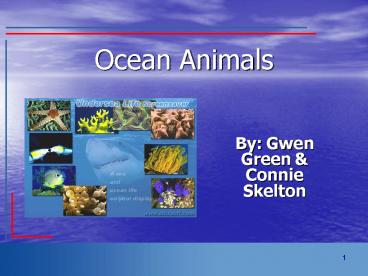Ocean Animals - PowerPoint PPT Presentation
1 / 18
Title:
Ocean Animals
Description:
These can be pieced together for an oceans quilt. ... You will research different ocean animals and make a quilt piece illustrating the creature. ... – PowerPoint PPT presentation
Number of Views:1098
Avg rating:3.0/5.0
Title: Ocean Animals
1
Ocean Animals
- By Gwen Green Connie Skelton
2
Ocean and Undersea LifeFor the Teacher
3
Lesson Overview
- This unit can be presented as a school wide
theme or for an individual class. It is not all
inclusive and does not represent all that is
available for classroom instruction where oceans
and undersea life are concerned. The unit is
divided up into sections allowing the teacher to
pick and choose to fit their needs.
4
Instructional Goals
- Students will study the oceans and seas of the
world, the animal life that swims in them and the
countries that border them.
5
Formative Assessment
- Ask students to write a short paper
highlighting the major issues that made an
impression on them during the visit and while
studying the unit. - Provide materials for them to illustrate the
paper. - Did the papers accurately portray major themes
covered? - Do students seem to have a grasp of the
variety of areas concerned with ocean and
undersea life?
6
Opening The Lesson
- Ask students, "What do you know about the
ocean? Accept all contributions without
correction. Give students a chance to discuss
their personal experiences relating to oceans.
Then ask, "What would you like to learn about the
ocean?" Record responses on a chart and display
the list for future reference.
7
Developing The Lesson Ocean Life Mural
- Students draw pictures of marine life.
Students work together to create a mural. - Explain the meaning of the word mural. If
possible, show students examples of murals from
art books or other sources. - Tell students that they are going to create a
mural showing creatures in the ocean. Have
students view pictures of sea life from library
sources or from the following sites The
SeaDive Medicine General Overview View of
Hazardous Marine LifeNOAH's Ark3-D Undersea
Life. - After students have viewed the pictures, tell
them to choose one they would like to add to the
mural. (Note Have each student choose a
different creature to add variety to the mural.)
Have students draw and color their pictures on
construction paper. - Have students cut out their pictures. Unroll the
large paper to the length desired. Have students
paste the pictures in different spots on the
roll. Display the mural on a classroom wall or in
a hallway. - Education World
8
Closing The Lesson
- Ask students to visit the Jason Project site.
Students can research different aquatic animals
at this site and then make a quilt piece
illustrating the creature. These can be pieced
together for an oceans quilt. You will need
squares of old cloth, scissors, needle and
thread, glue and any other materials to be
creative with.
9
Teacher Resources
- Materials Needed
- computers with Internet access or library sources
- construction paper
- a roll of large paper (brown, white, or if
available, blue) - art materials (crayons, markers, paint, etc.)
- glue
- squares of old cloth
- scissors
- needle and thread
- any other materials to be creative with.
10
Enrichment Activities
- Oceans of the World
- Students use the Internet or library sources
to compare and contrast information about the
Atlantic, Pacific, Indian, and Arctic Oceans.
Students also locate the oceans on a world map.
11
Enrichment Activities (Cont.) Oceans of
the World
- Ask students to name the four oceans. Have
students locate the oceans on a globe or world
map. - Divide the class into six groups. Assign each
group two oceans. The ocean pairings are
Atlantic-Pacific, Atlantic-Indian,
Atlantic-Arctic, Pacific-Indian, Pacific-Arctic,
Indian-Arctic. - Tell students that each group will research and
write reports about the oceans, noting their
similarities and differences. The comparison
reports should include information about the
oceans' locations, areas, climates, coastlines,
natural resources, and elevations. - Students may use library sources or the following
Internet sites Atlantic Ocean, Pacific Ocean,
Indian Ocean, Arctic Ocean. Variation Have
students create comparison reports as PowerPoint
presentations.
12
Lesson Accommodations
- Reproduce a world map and create a
transparency of the map and use an overhead
projector to draw an enlarged version for a
bulletin board. Have students label the five
oceans (Atlantic, Pacific, Indian, Arctic, and
Antarctic). Have students draw real sea creatures
and pin them to the board on the oceans where
they are found.
13
Standardized Test Items
- Where does most of the Earths water come from?
- glaciers
- rivers
- oceans
- lakes
14
For The Student
Insert Image
15
Learning Goals
- Know the animal and plant life of the different
oceans. - Name the four oceans and the major seas.
- Name the countries bordering the four oceans.
16
Assessment
- You will label the four oceans on the overhead
and self check against the teachers master copy. - You will research different ocean animals and
make a quilt piece illustrating the creature.
17
Learning Activity
- You will be provided with Internet sites to do
your research. - You will be provided with all materials needed to
complete the activities.
18
Enrichment Activities
- Oceans of the World
- You should use the Internet or library sources
to compare and contrast information about the
Atlantic, Pacific, Indian, and Arctic Oceans.
Students also locate the oceans on a world map.































